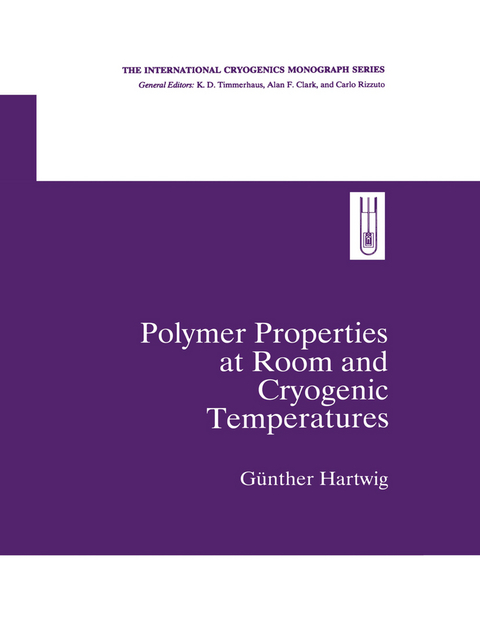
Polymer Properties at Room and Cryogenic Temperatures
Seiten
2010
|
Softcover reprint of hardcover 1st ed. 1995
Springer-Verlag New York Inc.
978-1-4419-3244-0 (ISBN)
Springer-Verlag New York Inc.
978-1-4419-3244-0 (ISBN)
Most descriptions of polymers start at room temperature and end at the melting point. This textbook starts at very low temperatures and ends at room temperature. At low temperatures, there are temperature ranges with negligible influences by glass transitions.
Most descriptions of polymers start at room temperature and end at the melting point. This textbook starts at very low temperatures and ends at room temperature. At low temperatures, may processes and relaxations are frozen which allows singular processes or separate relaxations to be studied. At room temperatures, or at the main glass transitions, many processes overlap and the properties are determined by relaxations. At low temperatures, there are temperature ranges with negligible influences by glass transitions. They can be used for investigating so-called basic properties which arise from principles of solid state physics. The chain structure of polymers, however, requires stringent modifications for establishing solid state physics of polymers. Several processes which are specific of polymers, occur only at low temperatures. There are also technological aspects for considering polymers at low temperatures. More and more applications of polymeric materials in low temperature technology appear. Some examples are thermal and electrical insulations, support elements for cryogenic devices, low-loss materials for high frequency equipments. It is hoped that, in addition to the scientific part, a data collection in the appendix may help to apply polymers more intensively in low temperature technology. The author greatly appreciates the contributions by his coworkers of the Kernforschungszentrum Karlsruhe in measurement and discussion of many data presented in the textbook and its appendix. Fruitful disccussions with the colleagues Prof. H. Baur, Prof. S. Hunklinger, Prof. D. Munz and Prof. R.
Most descriptions of polymers start at room temperature and end at the melting point. This textbook starts at very low temperatures and ends at room temperature. At low temperatures, may processes and relaxations are frozen which allows singular processes or separate relaxations to be studied. At room temperatures, or at the main glass transitions, many processes overlap and the properties are determined by relaxations. At low temperatures, there are temperature ranges with negligible influences by glass transitions. They can be used for investigating so-called basic properties which arise from principles of solid state physics. The chain structure of polymers, however, requires stringent modifications for establishing solid state physics of polymers. Several processes which are specific of polymers, occur only at low temperatures. There are also technological aspects for considering polymers at low temperatures. More and more applications of polymeric materials in low temperature technology appear. Some examples are thermal and electrical insulations, support elements for cryogenic devices, low-loss materials for high frequency equipments. It is hoped that, in addition to the scientific part, a data collection in the appendix may help to apply polymers more intensively in low temperature technology. The author greatly appreciates the contributions by his coworkers of the Kernforschungszentrum Karlsruhe in measurement and discussion of many data presented in the textbook and its appendix. Fruitful disccussions with the colleagues Prof. H. Baur, Prof. S. Hunklinger, Prof. D. Munz and Prof. R.
1 Introduction and General Polymer Features.- 2 Phonon Structure of Polymers.- 3 Specific Heat.- 4 Thermal Expansion and the Grueneisen Relation.- 5 Thermal Conductivity.- 6 Molecular Place Changes and Damping Spectra.- 7 Mechanical Deformation Behavior.- 8 Dielectric Properties and Their Correlations.- 9 Fracture Behavior of Polymers.- 10 Cryogenic Measuring Methods.- 11 Polymers as Matrix for Composites.- Appendix: Data Base.
| Erscheint lt. Verlag | 6.12.2010 |
|---|---|
| Reihe/Serie | International Cryogenics Monograph Series |
| Zusatzinfo | XII, 274 p. |
| Verlagsort | New York, NY |
| Sprache | englisch |
| Maße | 210 x 279 mm |
| Themenwelt | Naturwissenschaften ► Chemie ► Anorganische Chemie |
| Naturwissenschaften ► Chemie ► Organische Chemie | |
| Naturwissenschaften ► Physik / Astronomie ► Festkörperphysik | |
| Naturwissenschaften ► Physik / Astronomie ► Thermodynamik | |
| Technik ► Maschinenbau | |
| ISBN-10 | 1-4419-3244-5 / 1441932445 |
| ISBN-13 | 978-1-4419-3244-0 / 9781441932440 |
| Zustand | Neuware |
| Informationen gemäß Produktsicherheitsverordnung (GPSR) | |
| Haben Sie eine Frage zum Produkt? |
Mehr entdecken
aus dem Bereich
aus dem Bereich


